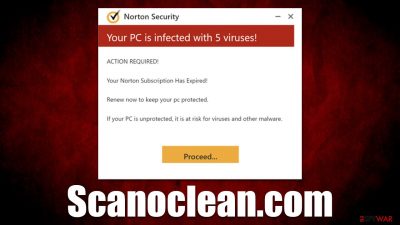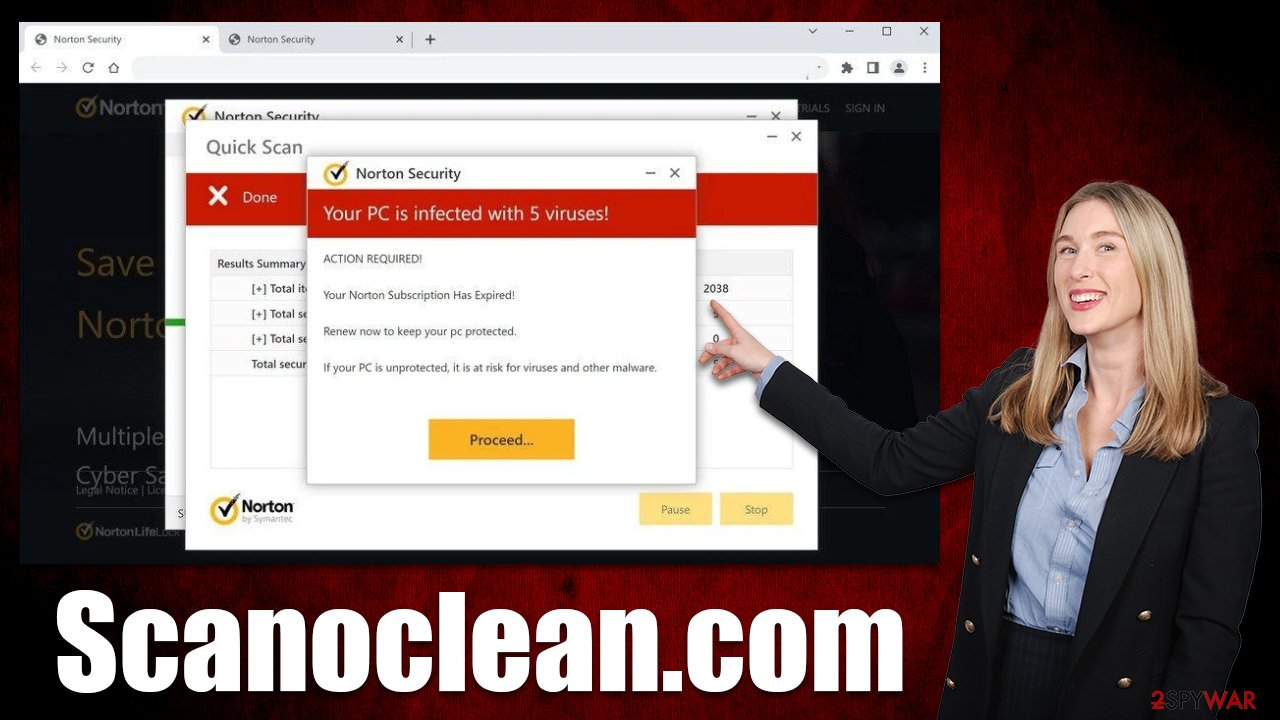Scanoclean.com ads (scam) - Chrome, Firefox, IE, Edge
Scanoclean.com ads Removal Guide
What is Scanoclean.com ads?
Scanoclean.com ads are fake: crooks use them for profit

Scanoclean.com is a scam website that seeks to benefit from affiliate links in a deceptive manner, where users always end up being victims. People usually end up on this website by accident after clicking a malicious link somewhere else, which adds to the overall surprise and success of the scheme.
Scanoclean.com impersonates a system scan allegedly done by a popular security vendor Norton. The fake results claim that the system has been infected with malware, and needs to be cleaned, at which point users are then redirected to a download page of security software. Scammers benefit from each of the clicks and downloads made, while users might end up with software they don't need.
In some cases, the advertised software might even be malicious, thus downloading applications from scam sites shouldn't be an option at all. If you have installed something from Scanoclean.com, you should proceed with the instructions below on how to recover.
| Name | Scanoclean.com |
| Type | Scam, phishing, redirect, adware |
| Operation | Claims that the subscription for security software has expired and that it needs to be renewed immediately. Asks to download malicious software and enable push notifications |
| Distribution | Redirects from other malicious websites, adware |
| Risks | Installation of PUPs or malware, sensitive information disclosure, financial losses |
| Removal | You should not interact with the contents shown by a scam website, check your system for adware or malware infections with SpyHunter 5Combo Cleaner security software |
| Other tips | Third parties can use cookies to continue tracking your online activities, so we recommended clearing browser caches and other leftover files with FortectIntego |
The scam scheme and how to spot deception
Norton is one of the most established and oldest security vendors out there, hence many people can associate its name with something trustworthy. Using the name, the logos, and the feel of the security software provides Scanoclean.com with more credibility in a sense, where users believe that the warning is actually coming from a reputable vendor.
In fact, we have seen a rise in phishing[1] websites that imitate security scans from Norton or McAfee recently – Strist.online, Protectionsrequired.com, or Defenceprogramm.com are just a few examples of such. If you check the URL names, you would quickly notice that scammers are using words associated with security, computer scans, and similar.
All of these websites operate in an identical manner, which goes as follows:
- users are first exposed to a fake pop-up window of what seems to be Norton antivirus
- a fake scan is initiated, which shows several pop-ups with alleged detections
- after a few seconds, users are presented with fake results which claim that the system is infected with 5 viruses and that the security software subscription has expired.

If the “Proceed” button is clicked, users are then automatically rerouted to a website where they are asked to purchase anti-malware. If you have anti-malware already installed, you don't need an extra tool. Besides, crooks might direct you to download rogue security tools, which could actually infect your device.
Never believe Scanoclean.com pop-ups and messages, as they are all fabricated. In fact, any website which claims that your system is infected is faking it, as only reputable anti-malware is capable of detecting malicious software on your system.
Remediation steps
It is important to say that the remediation process depends on your actions taken whenever you encountered the Scanoclean.com scam. For example, if you have downloaded any software from the offered links, you should immediately uninstall it and then scan your computer with SpyHunter 5Combo Cleaner or Malwarebytes anti-malware. Security software can check the system fully and remove all malicious components that could otherwise be missed.
Likewise, adware could already be installed on your system, as those affected are more likely to encounter various phishing content, among persistent ads. Most adware can be removed automatically with security software, although some apps might not be detected due to PUPs being a gray area issue. Thus, we recommend checking manual steps as well.
First of all, we recommend uninstalling unwanted applications that are installed on the system level:
Windows
- Enter Control Panel into the Windows search box and hit Enter or click on the search result.
- Under Programs, select Uninstall a program.
![Uninstall from Windows 1 Uninstall from Windows 1]()
- From the list, find the entry of the suspicious program.
- Right-click on the application and select Uninstall.
- If User Account Control shows up, click Yes.
- Wait till the uninstallation process is complete and click OK.
![Uninstall from Windows 2 Uninstall from Windows 2]()
Mac
While moving apps into Trash is how you delete most normal applications, adware[2] tends to create additional files for persistence. Thus, you should look for .plist and other files that could be related to the virus. If you are not sure, skip this step entirely.
- From the menu bar, select Go > Applications.
- In the Applications folder, look for all related entries.
- Click on the app and drag it to Trash (or right-click and pick Move to Trash)
![Uninstall from Mac 1 Uninstall from Mac 1]()
To fully remove an unwanted app, you need to access Application Support, LaunchAgents, and LaunchDaemons folders and delete relevant files:
- Select Go > Go to Folder.
- Enter /Library/Application Support and click Go or press Enter.
- In the Application Support folder, look for unwanted entries and then delete them.
- Now enter /Library/LaunchAgents and /Library/LaunchDaemons folders the same way and terminate all the related .plist files.
Your next task is to check your browser for unwanted extensions, as adware commonly spreads as such. You can find the installed apps by clicking the “Extensions” button next to the settings menu, or you could access settings and get rid of the add-ons through there – we explain how below.
We also recommend cleaning browser caches for the best results, as adware is known for its data-tracking capabilities. Tracking cookies,[3] for example, are stored locally within special folders. You can delete them manually, or employ FortectIntego maintenance utility as a quicker solution.
Google Chrome
- Open Google Chrome, click on the Menu (three vertical dots at the top-right corner) and select More tools > Extensions.
- In the newly opened window, you will see all the installed extensions. Uninstall all the suspicious plugins that might be related to the unwanted program by clicking Remove.
![Remove extensions from Chrome Remove extensions from Chrome]()
Clean browser caches:
- Click on Menu and pick Settings.
- Under Privacy and security, select Clear browsing data.
- Select Browsing history, Cookies and other site data, as well as Cached images and files.
- Click Clear data.
Mozilla Firefox
- Open Mozilla Firefox browser and click on the Menu (three horizontal lines at the top-right of the window).
- Select Add-ons.
- In here, select unwanted plugin and click Remove.
![Remove extensions from Firefox Remove extensions from Firefox]()
Clean browser caches:
- Click Menu and pick Options.
- Go to Privacy & Security section.
- Scroll down to locate Cookies and Site Data.
- Click on Clear Data…
- Select Cookies and Site Data, as well as Cached Web Content and press Clear.
MS Edge
- Open Edge and click select Settings > Extensions.
- Delete unwanted extensions by clicking Remove.
![Remove extensions from Chromium Edge Remove extensions from Chromium Edge]()
Clear caches:
- Click on Menu and go to Settings.
- Select Privacy and services.
- Under Clear browsing data, pick Choose what to clear.
- Under Time range, pick All time.
- Select Clear now.
Safari
- Click Safari > Preferences…
- In the new window, pick Extensions.
- Select the unwanted extension and select Uninstall.
![Remove extensions from Safari Remove extensions from Safari]()
- Click Safari > Clear History…
- From the drop-down menu under Clear, pick all history.
- Confirm with Clear History.
How to prevent from getting adware
Choose a proper web browser and improve your safety with a VPN tool
Online spying has got momentum in recent years and people are getting more and more interested in how to protect their privacy online. One of the basic means to add a layer of security – choose the most private and secure web browser. Although web browsers can't grant full privacy protection and security, some of them are much better at sandboxing, HTTPS upgrading, active content blocking, tracking blocking, phishing protection, and similar privacy-oriented features. However, if you want true anonymity, we suggest you employ a powerful Private Internet Access VPN – it can encrypt all the traffic that comes and goes out of your computer, preventing tracking completely.
Lost your files? Use data recovery software
While some files located on any computer are replaceable or useless, others can be extremely valuable. Family photos, work documents, school projects – these are types of files that we don't want to lose. Unfortunately, there are many ways how unexpected data loss can occur: power cuts, Blue Screen of Death errors, hardware failures, crypto-malware attack, or even accidental deletion.
To ensure that all the files remain intact, you should prepare regular data backups. You can choose cloud-based or physical copies you could restore from later in case of a disaster. If your backups were lost as well or you never bothered to prepare any, Data Recovery Pro can be your only hope to retrieve your invaluable files.
- ^ Phishing attacks. Imperva. Application and data security.
- ^ Adware. Investopedia. Source of financial content on the web.
- ^ Tracking cookies: What are tracking cookies and how do they work?. Norton. Security research blog.







